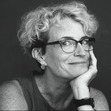Ashton Applewhite's Blog: This Chair Rocks
November 19, 2025
The boomers ruined everything? Think again.
In anxious times we look for scapegoats, so boomer-bashing is on the rise. Wondering how to push back? Here’s a quiz:
Cheer up, they’re dying off!The boomers invented [the internet/water bed/etc.]. What does your [entitled/tech-addicted/etc.] generation have to show for itself?It’s about class, not age.
It’s easier to point fingers than to address what’s actually going on. So blame the actual culprits: the rich. The politicians, lobbyists, technocrats, and corporate leaders who’ve shaped a system that benefits other wealthy people at the expense of the common good. Since the financial crisis of 2008, almost 100% of the country’s economic growth has gone to the to the families of the 1%, and they’re doing just fine. As for the underlying forces, blame predatory capitalism, unfettered by shifting political power. It’s not about age. It’s about class.
Both the 1% and the 99% are made up of all ages .
Americans born into the postwar economic boom were indeed demographically fortunate. The benefits, however, were not evenly distributed. As leading economists have long pointed out, growing wealth disparity within different age cohorts (not between them) underlies the shrinking prospects of ordinary Americans. It’s about class, not age.
For a clear explanation of what happened to the more egalitarian social contract that followed World War II, and who benefited from its destruction, read No, the Boomers Did Not Take It All in The American Prospect, by journalist Robert Kuttner. Hint: “It wasn’t ‘boomers’….It was Ronald Reagan and the presidents who followed.” Including the Democrats. It’s not about political party or “gerontocracy.” It’s about class and power.
Media coverage is not neutral.
Kuttner’s article is subtitled, “Why is the New York Times validating the generational myth, as opposed to taking a hard look at power and class?” Because the status quo serves the New York Times Company’s neoliberal agenda quite nicely; why upset the apple cart? That agenda prioritizes protecting private property over providing social services—services that disproportionately benefit the young and the old. Old people make better targets than kids, and much New York Times coverage is ageist. (Age advocate Stella Fosse lays out the paper’s sorry record on age bias here.)
Most mainstream media outlets are for-profit companies with sharp eyes on the bottom line. Editors know that generational labels attract readers, and that conflict = clickbait. Of course media outlets have options, and could choose not to advance the misleading narrative that the old profit at the expense of the young—especially in these divided times. Check out journalist Sheila Callaham’s analysis in Forbes of how the Wall Street Journal and the New York Times covered the same story: older Americans not selling their homes. Guess which one steered clear of the “boomers caused the housing crisis” trope?
Look beyond date-of-birth.
Yes, people born in the aftermath of WWII were lucky. That doesn’t make them the enemy. The housing shortage isn’t a selfish-old-person problem, it’s a housing-market problem. It’s a result of policy failures compounded by economic barriers and demographic shifts, and it affects Americans across the age spectrum. Only the wealthy are protected. It’s about class, not age.
Far more resources have always flowed from old to young. That’s as it should be. Already underway, the Great Wealth Transfer is moving an unprecedented $124 trillion from older to younger Americans. However, as with the postwar economic boom, the benefits are not equally distributed. Although high- and ultra-high-net-worth households make up only 2% of American households, they’ll receive over half that money and will pass it on to their already-super-rich children.
Don’t let age divide us.
In 2023 the Pew Research Center stopped using generational labels to avoid contributing to generational conflict, and suggested that others follow suit. The more energy we waste on generational finger-pointing, the less likely we are to join forces to demand a society that works for all ages. Blaming America’s ills on old people—or on immigrants or feminists or trans folks, for that matter—divides us and distracts us from what’s actually going on. The only winners in this blame game are the ultra-wealthy. Once again, it’s about class, not age.
The story we need to tell isn’t about boomers vs. millennials. It’s about the rich and powerful vs. the rest of us.
November 6, 2025
Two new friends, four new books
That’s the title of my latest newsletter. I know you’re in it for the pictures, and this one has lot’s of ’em. Here’s one to whet your appetite: me on stage with the genuinely fabulous Rita Moreno in Oakland on October 7. She is hilarious—and I made her laugh too 
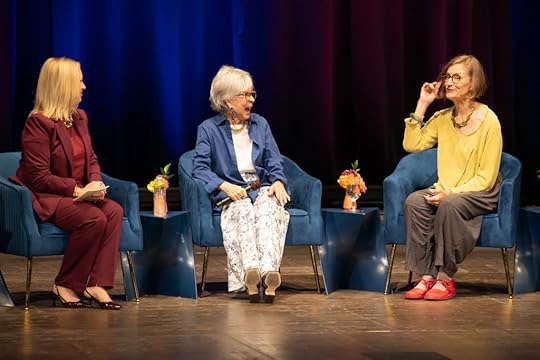
October 9, 2025
It’s Ageism Awareness Day!
Here’s a superb collection of ways to support Ageism Awareness Day from the American Society on Aging. As they point out, narrow views of aging and old vs. young framing are barriers to creating “a society that works for us all—once we get past ageism.” Want more suggestions? “Don’t just talk about it, BE about it!” urges anti-ageism champion Janine Vanderburg.
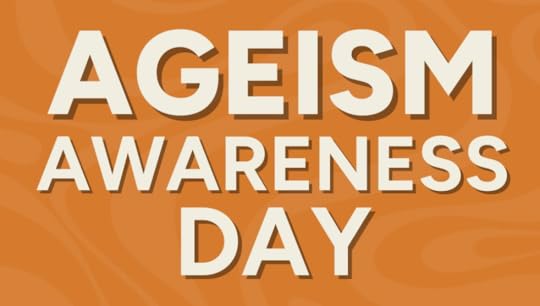
This year I’m asking people in ageland to reflect on whether their actions and organizations are actually anti-ageist. The Old School Hub has wrestled with that question for almost a decade now, because we focus on explicitly addressing ageism.
A recent query from a national organization challenged us to clarify our criteria. The organization described their nearly two million participants as “anti-ageist in spirit, even if they aren’t holding rally signs.” Seeking to be added to Old School’s resource bank, they asked: “Can an organization be anti-ageist even if it doesn’t explicitly use that term?”
We reframed the question more broadly: “Can an organization support age equity without committing explicitly to that mission?” We thought hard. Here’s our answer: “As we see it, supporting age equity means foregrounding the need to educate people about ageism and to confront it in some way. Otherwise the organization’s position is neutral, not anti-ageist. That allows the status quo, which is inequitable, to persist.”
I’m delighted to report that the organization decided to collaborate with Old School on ways to respond to our challenge. Would you or your organization like to do the same? Tell me more.
September 30, 2025
latest newsletter
This one is different. So different I drew this illustration.

July 27, 2025
What the “doom loop” narrative about population aging has wrong
This guest post is by Paul Kleyman, National Coordinator of the Journalists Network on Generations., which he co-founded in 1993. He edits its newsletter, Generations Beat Online, to which I’m indebted for countless thoughtful analyses of aging-related social and economic policies, and as well as how these stories get covered. In the current issue. This article appeared in the latest issue.
“This Doom Loop Will Hit Every Aspect of Our Lives” was the Page One banner headlineof a special, San Francisco Chronicle Sunday edition, July 13, 2025: The Dek: “Population, Among Oldest in the nation, could put region’s continued prosperity at risk.”
The package, labeled The Graying Bay, covered nearly eight broadsheet pages (about half of the entire A section of the print edition) with individual stories also serialized earlier in the week). Sourly, the section reinforces the negative slant on aging in American culture and mainstream media, as a growing “burden” on the nation’s housing, health and economic wellbeing.
The stories on such topics as the San Francisco area’s increasingly unaffordable housing do contain useful and up-to-date data with some accurate background on operative factors. Yet even discussions about the pressures on Bay Area elders, such as housing, are framed as impediments to young families and the region’s “Future.”
For instance, the two-page story, “Fastest-aging Neighborhood could forecast Bay Area’s future,” (fully covering 2 pages with photos) by Connor Letourneau, accurately recalls how California’s 1978 ballot measure, Proposition 13, whichled the national “taxpayer’s revolt, froze property taxes for long-time homeowners. That locked in low costs for many in ways that have kept older residents from moving, even when they wanted to, effectively squeezing housing stock for the young.
What Letourneau (10 years at the Chronicle, U of Maryland graduate, in 2013) did not describe is how Proposition 13 and its clones around the nation merely exacerbated a national housing crisis already aggravated by the federal government’s 30-year lid on subsidies for new low-income housing. (It was only lifted in 2024 by the Biden administration, a story covered by the Chronicle only a year ago.)
The Bay Area’s well-documented loss of older homeowners and renters have resulted from a range of intergenerational factors. Topping the list is high regional costs leading to post-pandemic evictions, job losses and so much more.
Further, those 50-plus now constitute the fastest-growing segment of the Bay Area’s homeless population. Pervasive age discrimination has hit older workers everywhere. Prop 13’s statewide clump on education funding plunged California’s public learning—and many family’s future, from among the country’s top-rated to near the bottom in the United States. And multiple other cost-of-living factors affecting people across the age spectrum.
Instead, Letourneau notes, “Due to longer life expectancy, tumbling birth rates and the graying of the baby boomers, the U.S. population has a greater proportion of elderly adults that at any other time since the government began tracking such data 175 years ago.” He continues, “With experts expecting the nation’s rapid-aging trend to shift into overdrive, no single force could shape America more in the coming decades that its older demographics. The ramifications will rip through every part of society, placing unprecedented demands on housing, health care, education and social services.”
Ramifications of population aging to rip through our social fabric? Yes, that’s surely a fulfillable prophesy. What this and the other “Graying Bay” stories miss is the healthy and productive promise of what gerontologists call “the longevity bonus.” Those vigorous added years may bring—given greater social investment in an aging-friendly, diverse socio-economic order.
For example, as I reported in my recent story, Aging in America News (April 1, 2025), “In the United States, according to the report, The Economic Impact of Age Discrimination, AARP and The Economist magazine found that age bias against Americans 50-plus reduced U.S. GDP by $850 billion in 2018 alone.
According to the study, a concerted public-private effort to end age discrimination for 50-plus workers would add $3.9 trillion more to the economy in 2050 (for a total contribution that year of $30.7), than possible have without change.”
The Graying Bay stories quote very few of the leading social gerontologists from the region’s top universities, expert who might have broadened the scope of these lengthy pieces.
In the end, regarding this “special” coverage of the Graying Bay, there’s both bad news and good news. The bad: Well, read the above. The good news: the San Francisco Chronicle’s paywall is so hard that most non-subscribers, such as journalists, having any interest in the topic will never see it.
July 9, 2025
The thing about ‘ageing gracefully’

The Guardian asked me to tackle a very juicy topic for a series on aging well: what it means to “age gracefully.” Here’s what I, and quite a few others, had to say on the subject. Spoiler alert: it’s complicated. Also funny.
June 19, 2025
Introducing Alessandro Negrete – Executive Director of the Old School Hub
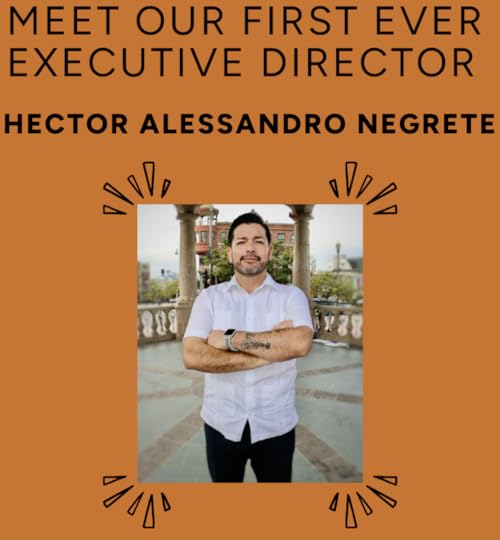
n 2018, Ryan Backer, Kyrié Carpenter, and I launched the Old School Clearinghouse: a central repository for free information about ageism and how to undo it. It grew, becoming a go-to site for age advocates and the general public, and a meeting place during the pandemic. Last year, with a brilliant new logo and look by Paul Belford, the organization transitioned into Old School A Hub for Age Equity + Ageism Awareness.
Earlier this year we realized that in order to expand Old School’s reach and impact we had to find an executive director—the right one. Over 100 terrific candidates applied for the position, and we offer a thousand thanks to Janine Vanderburg + Wendy Silveira-Steinway for guiding us through an exhaustive hiring process. We are delighted to announce that Hector Negrete will step into the position on June 30th. You can learn more about him here.
May 9, 2025
The age equity movement is growing. Want in?
Old School, the small-but-mighty grassroots organization I co-founded in 2018, is looking for an Executive Director. More info + links in my latest newsletter. Also pix from the American Society on Aging’s annual conference last month, which embraced my YODA concept—let’s talk about age and power. And announcing the WHO Ageism Experiences Scale, which capture ageism in all its dimensions. As the extraordinary WHO team said at the launch on May 28, “Measures are how we learn.” This is a nothing less than a groundbreaking tool for age advocates everywhere.
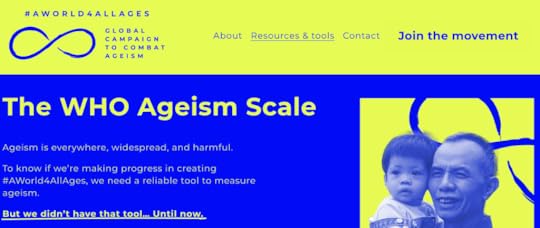
April 15, 2025
Big news: the Old School Hub is looking for an Executive Director
In 2018, two colleagues and I launched the Old School Clearinghouse: a comprehensive database of free ageism-related resources. Not exactly sexy, but people were hungry for it and Old School soon became the go-to site for age advocates and the general public. Last year, the clearinghouse transitioned into the Old School Hub for Age Equity and Ageism Awareness and expanded its mission: to educate people about ageism and how to dismantle it, and to connect and support people doing this work.
Our small-but-mighty grassroots organization is already playing a key role in advancing a world where aging is a fundamental human right. Now we’re ready to expand our reach and impact. This means hiring a visionary Executive Director—someone who:
• is eager to play a leading role in the movement for age equity;
• has a proven track record in organizational management, fundraising, and strategic growth;
• shares our values and enjoys working collaboratively.
Could this be you? If so, we encourage you to apply. Or do you know someone who possesses the necessary skills and shares our values? Please let them know that Old School is hiring. Visit oldschool.info/jobs to read the full job description and how to apply. Please share the link widely with anyone you believe would be a strong candidate. We’re committed to finding someone exceptional to lead Old School into its next chapter.
April 14, 2025
Four ways to deploy age against the awfulness:
• Take advantage of the fact that age ≠ “woke.” Because ageism is still so unexamined, most people don’t think of age as a criterion for diversity. Unlike race, or gender, or sexual orientation, it doesn’t set off the “DEI alarm.” That gives it subversive potential. Foregrounding age can serve as a Trojan Horse. It’s a way to slip under the radar, as it were: to cross divides without compromising egalitarian values. We know that mixed-age groups are more mixed in other ways too. Not only is the global population growing younger, it’s also becoming also queerer and more racially mixed. Instead of turning people off by preaching diversity and inclusion—tempting though it is, don’t get me wrong —we can meet people where they are, and advance all kinds of agendas.
• Create and promote mixed-age initiatives. In recent years, intergenerational initiatives have cropped up all over. Because they center age, they’re politically neutral. No one’s against ’em, whether they’re business consultants seeking to monetize so-called “generational divides” or advocates like me who’d like to do away with generational labels entirely. This means intergenerational initiatives can serve all kinds of purposes. It makes sense to create and support them for a number of reasons. We know that connecting generations reduces ageism. Mixed-aged teams and initiatives are more effective. They’re also inherently more diverse and inclusive—ssssssh!
• Challenge old vs. young framing. Politicians around the world are exploiting racial, gender, and class divides. We can’t afford to add age to the mix. This means challenging old vs. young framing wherever we encounter it, as when older people are scapegoated for sucking up all the wealth, or for hoarding political power, or for not caring about the planet we leave behind. Both the 1% and the 99% are made up of all ages. Plenty of white supremacists are young and climate change activists old, etc. etc. As ever, the issue is ideology, not age. Now more than ever, we need to avoid weaponizing age gaps and to join forces across them.
• Bring people of all ages together to talk about age and power. Here’s my proposal, which I’ve dubbed it YODA, for Youngers and Olders Dismantling Ageism. I see YODA as a way to derail old vs, young framing, identify shared goals, and find ways to support each other across age gaps. I’m encouraging people to run with the idea in any context and at any scale that appeals, and it’s getting lots of traction.
• Examine the language we use. At a Stanford Longevity Center event last month my ears perked up when sociologist Sasha Johfre said: “Age, gender, and race are pretty arbitrary categories, which we use to socially locate people. We’re always thinking about people across these categories.” That, I realized, was a great way to explain intersectionality, and a substitute for that clunky word. Intersectionality is an incredibly important concept; thank you Kimberlé Crenshaw. It’s also jargon that a lot of people don’t understand and that now signals “woke.” Revising my YODA article for the umpteenth time, I realized I could apply the same lens to other terms now censored by the thought police—swap “common cause” for “solidarity,” for example, and “building bridges” for “allyship”—without losing a thing.

